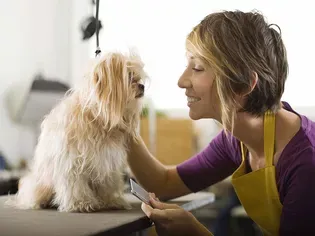How to Groom a Puppy
Updated on 04/26/24

Puppy Grooming: A Comprehensive Guide to Caring for Your Furry Friend
Welcoming a new puppy into your life is a joyous occasion, but it also comes with a responsibility to ensure their well-being and hygiene. Regular grooming is an essential aspect of puppy care, not only to keep them looking their best but also to maintain their health and comfort. This comprehensive guide will provide you with all the knowledge and techniques you need to groom your puppy like a professional.
Establishing a Grooming Routine
Consistency is key when it comes to puppy grooming. Establish a regular schedule that works for both you and your puppy, and stick to it as much as possible. The frequency of grooming will vary depending on your puppy's breed, coat type, and activity level, but once or twice a week is a good starting point.
Essential Grooming Tools
Before you start grooming your puppy, make sure you have the following essential tools:
* Slicker brush: Removes loose hair and tangles
* Pin brush: Smoothes and detangles the coat
* Comb: Removes knots and mats
* Scissors: Trim excess hair
* Nail clippers: Trim nails
* Toothbrush and toothpaste: Clean teeth
* Ear cleaner: Clean ears
* Puppy shampoo and conditioner: Bathe your puppy
Step-by-Step Grooming Guide
1. Brushing:
* Use a slicker brush to remove loose hair and tangles.
* Follow with a pin brush to smooth and detangle the coat.
* Brush in the direction of your puppy's hair growth, avoiding any areas that are sensitive or matted.
2. Combing:
* Use a comb to remove any remaining knots or mats.
* Hold the base of the hair to prevent pulling and discomfort.
* If you encounter a large mat, gently work it out with your fingers before combing.
3. Trimming:
* Use scissors to trim any excess hair around the paws, ears, and tail.
* Be careful not to cut too close to the skin.
* If your puppy's coat is matted or tangled, you should consider taking them to a professional groomer.
4. Nail Clipping:
* Use nail clippers to trim your puppy's nails regularly.
* Cut only the white or clear part of the nail, avoiding the quick (pink area) which contains blood vessels.
* If you are unsure how to clip your puppy's nails, consult with a veterinarian or professional groomer.
5. Dental Care:
* Brush your puppy's teeth with a puppy-specific toothbrush and toothpaste 2-3 times a week.
* Start brushing their teeth as early as possible to establish good oral hygiene habits.
* If you notice any signs of dental disease, such as bad breath or bleeding gums, contact your veterinarian.
6. Ear Cleaning:
* Use a cotton ball or gauze pad dipped in ear cleaner to gently clean your puppy's ears.
* Do not insert anything into the ear canal.
* If you notice any redness, discharge, or odor from your puppy's ears, consult with your veterinarian.
7. Bathing:
* Bathe your puppy once every 1-2 weeks, or as needed.
* Use a puppy-specific shampoo and conditioner to avoid irritating their skin.
* Rinse thoroughly and towel dry your puppy after bathing.
Desensitizing Your Puppy to Grooming
Start grooming your puppy as early as possible to accustom them to the process. Make the experience positive by giving them treats, praising them, and speaking to them in a soothing voice.
* Introduce tools gradually: Start by showing your puppy the grooming tools and letting them sniff them.
* Touch and handle them: Gently touch and handle your puppy's paws, ears, and tail, and gradually increase the time spent grooming them.
* Make it fun: Incorporate grooming into playtime by using grooming tools as toys.
Special Considerations for Different Coat Types
Different breeds of puppies have different coat types that require specific grooming techniques:
* Short-haired puppies: Require regular brushing to remove loose hair.
* Long-haired puppies: Require daily brushing to prevent tangles and mats.
* Curly-haired puppies: Require regular brushing to maintain their curls and prevent matting.
* Hypoallergenic puppies: Require regular brushing to keep their skin clean and free of dander.
Conclusion
Grooming your puppy is an essential part of their care and well-being. By following these steps and establishing a consistent routine, you can keep your puppy looking their best and feeling their happiest. Remember to consult with a veterinarian or professional groomer if you have any specific questions or concerns. With a little patience and practice, you and your puppy will enjoy the bonding experience of grooming and the satisfaction of a well-groomed companion.
Explore More Pets

Basic Training
Puppy and Baby Introductions

Working Dog Breeds
All About Search and Rescue Dogs

Dog Treatments
Puppy Vaginitis: Signs, Causes and Treatment

Dog Adoption
After More Than 1,200 Days in the Shelter, Coco Goes Home

Basic Training
How to Train Your Puppy to Go on Potty Pads

Hybrid Dog Breeds
The Difference Between a Mutt, Mixed Breed, or Designer Dog?

Dog Treatments
Nail Problems in Dogs

Puppies
7 Reasons Why Two Dogs Are Better Than One